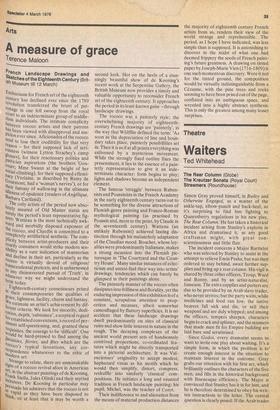Arts
A measure of grace
Terence Maloon
French Landscape Drawings and Sketches of the Eighteenth Century (Britlah Museum till 12 March)
Enthusiasm for French art of the eighteenth century has declined ever since the 1789
revolution transferred the brunt of pat ronage in one fell swoop from the royal court to an indeterminate group of middle
class individuals. The intimate complicity between rococo artists and their patrons has been viewed with disapproval and sus picion ever since. Aficionados of the rococo tend to lose their credibility for that very reason — for their supposed lack of seri ausness (witness Lytton Strachey's camp glosses), for their reactionary politics and Patrician aspirations (the brothers 'Gon court; Mme Swann at the height of her
social-climbing), for their supposed effemi,nacy (Verlaine, as described by Remy de %la ur mon t, had a 'woman's nerves'), or for their fantasy of wallowing in the ultimate idleness of opulence (readers of Ankelique, flarbara Cartland).
The only artists of the period now absolutelyassured of Old Master status are
surely the period's least representative figures: Watteau is the most technically awkWard and morbidly disposed exponent of the rococo, and Chardin is committed to a c°Mpletely antithetical aesthetic. The corn PlicitY between artist-producers and their eftrtly consumers would strike modern sensibility as a sure indication of mannerism and decline in their art, particularly as the rococo is virtually devoid of religious/ transcendental pretexts, and is unharnessed t° any disinterested pursuit of 'Truth', in Whatever way we might understand the tertn today. . Eighteenth-century connoisseurs prized M their contemporaries the qualities of grace, lightness, facility, charm and fantasy. We estimate an artist's achievement by different criteria. We look for sincerity, dedication, depth, 'substance', a sceptical regard for established conventions, a record of persistent self-questioning, and, granted these requisites, the courage to be 'difficult'. One would be hard-pressed to find among the fahlaisies, feeries, and fetes which are the r°coco's typical inventions, any corresPondence whatsoever to the ethic of Modern art. . Strange to relate, there are unmistakable Signs of a rococo revival afoot in American in the abstract paintings of de Kooning, Frank Stella, Jules Olitski and their myriad nnitators. De Kooning in particular may ' Persuade his admirers that the rococo is not ay! . vapid as they have been disposed to "Ink, or at least that it may be worth a
second look. Hot on the heels of a stunningly beautiful show of de Kooning's recent work at the Serpentine Gallery, the British Museum now provides a timely and valuable opportunity to reconsider French art of the eighteenth century. It approaches the period in its least-known guise —through landscape drawings.
The rococo was a painterly style; the overwhelming majority of eighteenthcentury French drawings are 'painterly', in the way that Wolfflin defined the term: 'As soon as the depreciation of line and boundary takes place, painterly possibilities set in. Then it is as if at all points everything was enlivened by a mysterious movement. While the strongly fixed outline fixes the presentment, it lies in the essence of a painterly representation to give it an indeterminate character: form begins to play; lights and shadows become an independent element.
The famous 'struggle' between Rubensists and Poussinists in the French Academy in the early eighteenth century turns out to be something for the diverse attractions of Flemish genre painting and Franco-Roman mythological painting (as practised by Poussin and, more to the point, by Claude in the seventeenth century). Watteau (an unlikely Rubensist) achieved lasting distinction through his melancholy adaptation of the Claudian mood. Boucher, whose loyalties were predominantly Italianate, makes a strong incursion into the Flemish picturesque in 'The Courtyard and the Country House'. Many similar instances of eclecticism and unrest find their way into artists' drawings, tendencies which can barely be glimpsed in their paintings alone.
The painterly manner of the rococo often dissipates into frilliness and floridity, yet the enduring impression of this exhibition is of a constant, scrupulous attention to proportion and measure, albeit somewhat camouflaged by fluttery superficies. It is no accident that these landscape drawings dwell predominantly on sites of classical' ruins and show little interest in nature in the rough. The decaying complexes of the ancient world present sets of handsomely contrived proportions, co-ordinated fea tures which might be directly transported into a pictorial architecture. It was Valenciennes' originality to accept modest, haphazard vistas as his motifs which he would then simplify, distort, compress, reshuffle into similarly 'classical' com positions. He initiates a long and vaunted tradition in French landscape painting; his pupil, Michel, was the teacher of Corot.
Their indifference to and alienation from the means of material production distances the majority of eighteenth century French artists from us, renders their view of the world strange and reprehensible. The period, as I hope I have indicated, was less simple than is supposed. It is astonishing to discover in the midst of what one had deemed frippery the seeds of French painting's future greatness. A drawing on tinted paper by Joseph-Marie Vien (1716-1809) is one such momentous discovery. Were it not for the tinted ground, the composition would be virtually indistinguishable from a azanne, with the pine trees and rocks seeming to have been prised out of the page, conflated into an ambiguous space, and wrestled into a highly abstract synthesis. This is only the greatest among many lesser surprises.


































 Previous page
Previous page